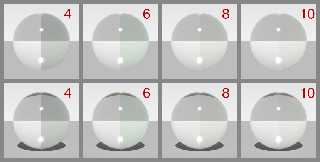|
 |
"Anthony D. Baye" <Sha### [at] spamnomore hotmail hotmail com> wrote:
> Personally, I'm not seeing anything, and I rendered the objects myself with the
> latest beta. It might be nice if you included your global photon settings, and
> perhaps the light source. The problem might be differences in
> viewing angle, angle of incidence, that kind of thing.
>
> Try rendering each one from the same angle. Rather than using a loop render the
> scene as frames of an animation with your parameters tied to the frame_number.
> Slice the images up and set each sphere side-by-side for comparison.
>
> "Cousin Ricky" <ric### [at] yahoo com> wrote:
> Personally, I'm not seeing anything, and I rendered the objects myself with the
> latest beta. It might be nice if you included your global photon settings, and
> perhaps the light source. The problem might be differences in
> viewing angle, angle of incidence, that kind of thing.
>
> Try rendering each one from the same angle. Rather than using a loop render the
> scene as frames of an animation with your parameters tied to the frame_number.
> Slice the images up and set each sphere side-by-side for comparison.
>
> "Cousin Ricky" <ric### [at] yahoo com> wrote:
> > It seems that the smaller the dispersion_samples, the darker the glass.
> > Could this be the 2 missing dispersion samples making their absence felt?
Top row was run with +kff5 declare=Ph=0 (faked caustics).
Bottom row was run with +kff5 declare=Ph=1 (photons).
Left half of each sphere has no dispersion; right half has dispersion_samples
set to the number in the frame.
_____________________________________________________________________
#ifndef (Ph) #declare Ph = no; #end
global_settings
{ assumed_gamma 1
max_trace_level 256
#if (Ph) photons { spacing 0.005 autostop 0 } #end
}
camera
{ location -5 * z
right x up y
angle 30
}
sky_sphere { pigment { gradient y color_map { [0 rgb 0.9] [1 rgb 0.5] } } }
light_source
{ <0, 1, -1> * 1000, rgb 1
parallel point_at 0
}
plane { y, -1 pigment { rgb 1 } }
sphere
{ 0, 1
pigment { rgbf 1 }
finish
{ reflection { 0 1 fresnel } conserve_energy
specular 1 roughness 0.001
}
interior
{ ior 1.5
#if (frame_number > 1)
dispersion 1.05
dispersion_samples frame_number * 2
#end
#if (!Ph) caustics 1 #end
}
photons { target reflection on refraction on collect off }
}
#if (frame_number > 1)
text
{ ttf "cyrvetic.ttf" str (frame_number * 2, 0, 0) 0.01, 0
pigment { rgb x }
no_shadow no_reflection
scale 0.4
translate <0.65, 0.65, -1>
}
#end com> wrote:
> > It seems that the smaller the dispersion_samples, the darker the glass.
> > Could this be the 2 missing dispersion samples making their absence felt?
Top row was run with +kff5 declare=Ph=0 (faked caustics).
Bottom row was run with +kff5 declare=Ph=1 (photons).
Left half of each sphere has no dispersion; right half has dispersion_samples
set to the number in the frame.
_____________________________________________________________________
#ifndef (Ph) #declare Ph = no; #end
global_settings
{ assumed_gamma 1
max_trace_level 256
#if (Ph) photons { spacing 0.005 autostop 0 } #end
}
camera
{ location -5 * z
right x up y
angle 30
}
sky_sphere { pigment { gradient y color_map { [0 rgb 0.9] [1 rgb 0.5] } } }
light_source
{ <0, 1, -1> * 1000, rgb 1
parallel point_at 0
}
plane { y, -1 pigment { rgb 1 } }
sphere
{ 0, 1
pigment { rgbf 1 }
finish
{ reflection { 0 1 fresnel } conserve_energy
specular 1 roughness 0.001
}
interior
{ ior 1.5
#if (frame_number > 1)
dispersion 1.05
dispersion_samples frame_number * 2
#end
#if (!Ph) caustics 1 #end
}
photons { target reflection on refraction on collect off }
}
#if (frame_number > 1)
text
{ ttf "cyrvetic.ttf" str (frame_number * 2, 0, 0) 0.01, 0
pigment { rgb x }
no_shadow no_reflection
scale 0.4
translate <0.65, 0.65, -1>
}
#end
Post a reply to this message
Attachments:
Download 'splice.png' (69 KB)
Preview of image 'splice.png'

|
 |




![]()